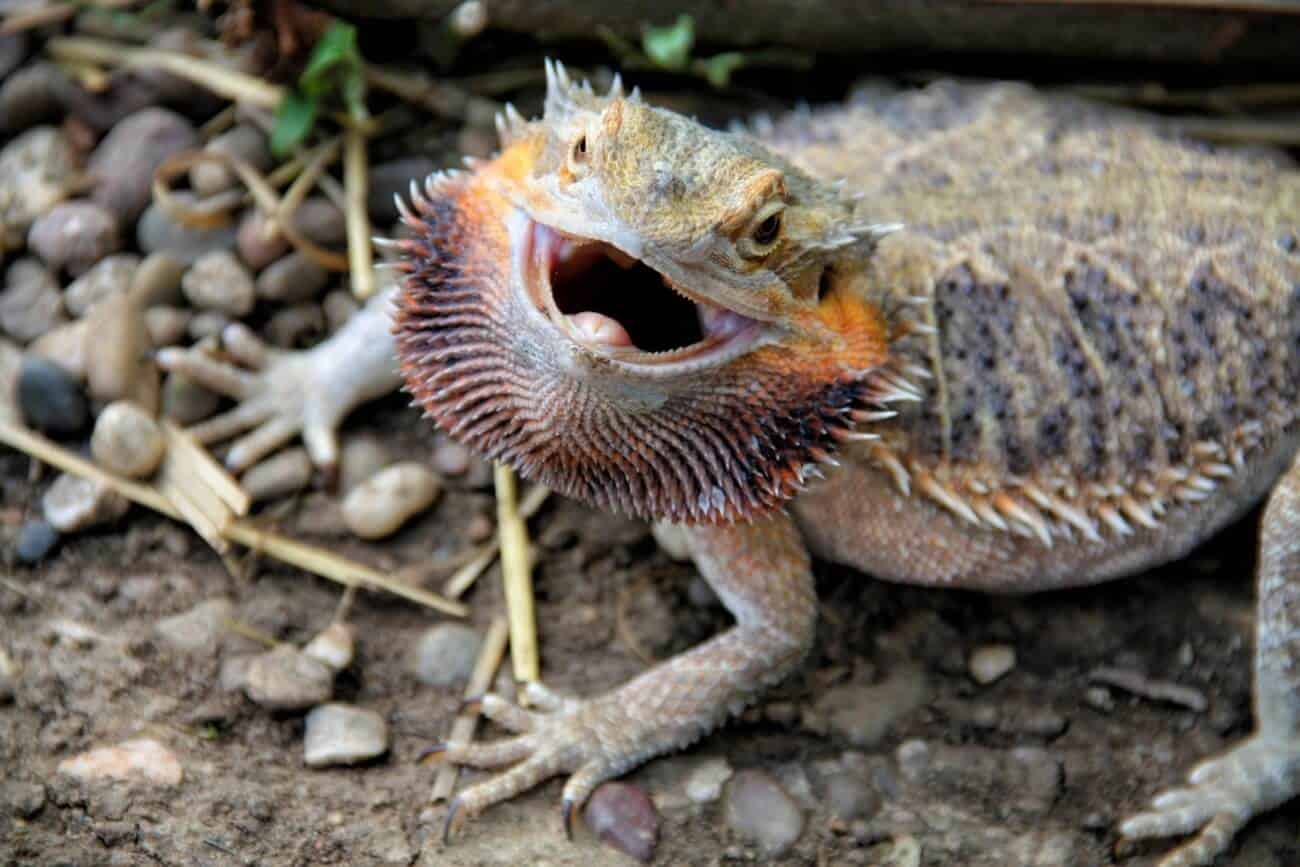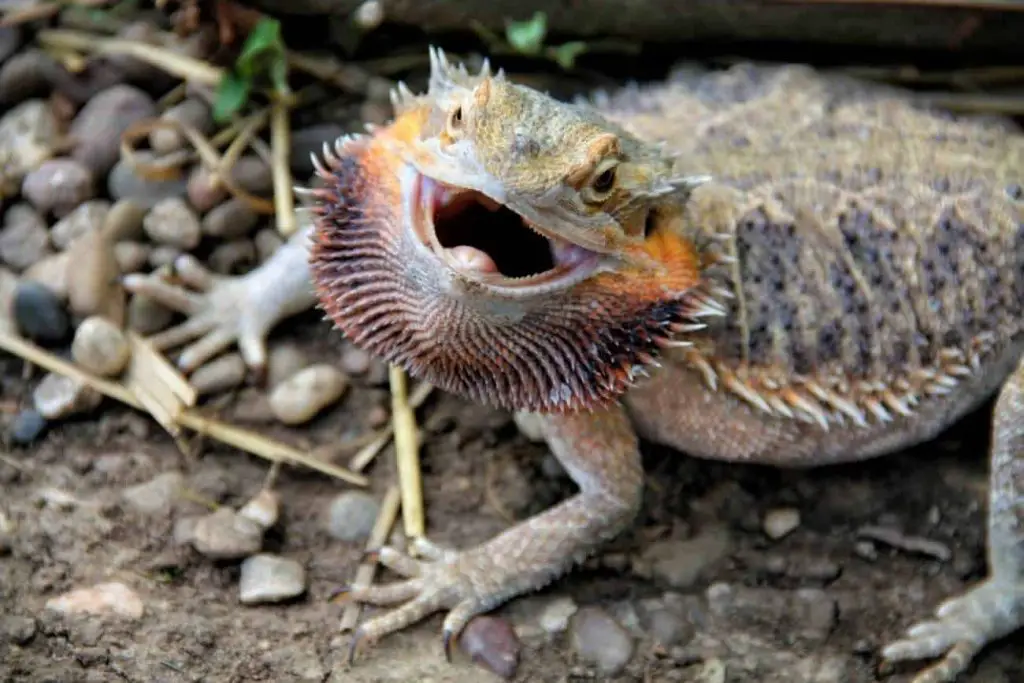Bearded dragons are fascinating creatures that are known for their unique behaviors. One of the most interesting behaviors that these lizards exhibit is puffing up their throats. This display can be both alarming and impressive, leaving many people wondering why they do it in the first place.
At first glance, it may seem like puffing up their throats is a sign of aggression or intimidation. However, there are actually several reasons why bearded dragons puff up their throats. In this article, we will explore the different reasons why bearded dragons exhibit this behavior and what it can tell us about their health and emotions.

Why Do Bearded Dragons Puff Up Their Throats?
Bearded dragons are fascinating creatures that have a unique way of communicating with each other and their environment. One of the most distinctive behaviors of bearded dragons is the way they puff up their throats and display their beards. This behavior is known as “bearding” and it can have several different meanings depending on the situation. In this article, we will explore the reasons why bearded dragons puff up their throats and what it means for their behavior.
1. Defense Mechanism
When bearded dragons feel threatened or scared, they can puff up their throats and display their beards as a way of defending themselves. This is a natural defense mechanism that helps them to appear larger and more intimidating to potential predators or threats. By puffing up their throats, they can also make it more difficult for predators to swallow them, as their throat will be wider and harder to swallow.
In addition to puffing up their throats, bearded dragons may also hiss or open their mouths wide to show off their teeth as a way of warning predators to stay away. It’s important to note that bearded dragons are not aggressive animals by nature and prefer to avoid conflict whenever possible.
2. Courtship Behavior
In addition to using bearding as a defense mechanism, bearded dragons also puff up their throats and display their beards as part of their courtship behavior. During mating season, male bearded dragons will puff up their throats and bob their heads to attract females. This behavior is known as “head bobbing” and it’s a way for males to show off their strength and dominance to potential mates.
If a female is interested, she will respond by bobbing her head back and forth and approaching the male. Once the male and female have established a connection, they will engage in a courtship dance that involves more head bobbing and other displays of affection.
3. Temperature Regulation
Bearded dragons are ectothermic animals, which means that they rely on external sources of heat to regulate their body temperature. When bearded dragons get too cold, they can puff up their throats and bask in the sun to absorb more heat. By puffing up their throats, they can also expose more of their body to the sun and absorb heat more efficiently.
Conversely, when bearded dragons get too hot, they can flatten their bodies and puff up their throats to increase air flow and cool down. This behavior is known as “gaping” and it allows them to dissipate excess heat and regulate their body temperature.
4. Sign of Dominance
Bearded dragons are social animals that live in groups in the wild. Within these groups, there is a hierarchy of dominance that is established through various displays of aggression and submission. Puffing up their throats and displaying their beards is one way that bearded dragons establish dominance over other members of their group.
If two bearded dragons encounter each other in the wild, they may puff up their throats and display their beards to assert dominance and establish their place in the hierarchy. This behavior is also seen in captive bearded dragons, especially when they are housed together in groups.
5. Sign of Submission
On the flip side, puffing up their throats can also be a sign of submission for bearded dragons. When confronted by a more dominant member of their group, a submissive bearded dragon may puff up its throat as a way of showing deference and avoiding conflict.
This behavior is also seen in captive bearded dragons, especially when they are housed together in groups. If two bearded dragons are housed together and one is more dominant than the other, the submissive dragon may puff up its throat and display its beard as a way of avoiding conflict and showing respect to the dominant dragon.
6. Sign of Illness
In some cases, puffing up their throats can be a sign of illness or respiratory distress in bearded dragons. If a bearded dragon is having trouble breathing or is experiencing a respiratory infection, it may puff up its throat as a way of trying to clear its airways.
If you notice your bearded dragon puffing up its throat excessively or if it appears to be struggling to breathe, it’s important to seek veterinary care as soon as possible. Respiratory infections can be serious and even life-threatening if left untreated.
7. Sign of Stress
Finally, puffing up their throats and displaying their beards can also be a sign of stress in bearded dragons. If a bearded dragon is feeling anxious or uncomfortable, it may puff up its throat as a way of trying to appear larger and more intimidating to perceived threats.
Signs of stress in bearded dragons can include loss of appetite, lethargy, and unusual behavior. If you notice any of these signs, it’s important to evaluate the environment and make adjustments as needed to reduce stress and promote a healthy, happy bearded dragon.
Conclusion
In conclusion, bearded dragons puff up their throats and display their beards for a variety of reasons, including defense, courtship, temperature regulation, dominance, submission, illness, and stress. By understanding the different meanings behind this behavior, you can better interpret your bearded dragon’s body language and provide the care and attention it needs to thrive.
Frequently Asked Questions
Bearded Dragons are fascinating creatures that are popular pets. One of the most intriguing behaviors of these reptiles is the puffing up of their throats. This behavior can be confusing for pet owners and those who are interested in these creatures. Here are five questions and answers that can help you understand why Bearded Dragons puff up their throats.
Why do Bearded Dragons puff up their throats?
Bearded Dragons puff up their throats as a way to communicate with other Bearded Dragons or to intimidate predators. When Bearded Dragons feel threatened or stressed, they will puff up their throats to make themselves look bigger. This is a defensive mechanism that helps them to protect themselves from potential predators. Additionally, Bearded Dragons may puff up their throats during mating season to attract a mate or during a dominance display to establish their position in a social hierarchy.
It is important to note that not all throat puffing is a sign of aggression or stress. Sometimes Bearded Dragons will puff up their throats as a way to regulate their body temperature. When they are too cold, they may puff up their throats to increase blood flow to the area and warm themselves up. In this case, the throat puffing is a natural and healthy behavior.
Is throat puffing harmful to Bearded Dragons?
Throat puffing is a natural behavior for Bearded Dragons and is not harmful when done in moderation. However, excessive throat puffing can be a sign of stress or illness. If your Bearded Dragon is constantly puffing up their throat, it may be a sign that they are not getting the proper care or nutrition that they need. Additionally, throat puffing can cause dehydration if your Bearded Dragon is not drinking enough water. It is important to monitor your Bearded Dragon’s behavior and consult with a veterinarian if you notice any concerning changes.
It is also important to note that not all throat puffing is the same. Bearded Dragons may puff up their throats to varying degrees depending on the situation. Mild throat puffing may be a sign of contentment or relaxation, while more exaggerated throat puffing may be a sign of aggression or intimidation. It is important to observe your Bearded Dragon’s body language and behavior to better understand their communication.
Can Bearded Dragons control their throat puffing?
Bearded Dragons have voluntary control over their throat muscles and can puff up their throats at will. This behavior is a conscious choice and can be used to communicate a variety of messages to other Bearded Dragons or predators. It is important to note, however, that excessive throat puffing can be a sign of stress or illness and should be monitored closely.
Additionally, Bearded Dragons may puff up their throats involuntarily as a reflex to certain stimuli, such as sudden loud noises or bright lights. This is a natural response and is not a cause for concern unless it is accompanied by other signs of distress or illness.
What other behaviors should I look for in my Bearded Dragon?
Bearded Dragons exhibit a variety of behaviors that can provide insight into their health and well-being. Some common behaviors to look for include basking in the sun, eating regularly, drinking water, and exploring their environment. Bearded Dragons may also display territorial behavior, such as head bobbing or arm waving, to establish their dominance or communicate with other Bearded Dragons.
If you notice any changes in your Bearded Dragon’s behavior, such as lethargy, loss of appetite, or excessive aggression, it may be a sign that they are experiencing stress or illness. It is important to seek veterinary care if you notice any concerning changes in your Bearded Dragon’s behavior or health.
How can I create a healthy environment for my Bearded Dragon?
Creating a healthy environment for your Bearded Dragon is essential for their health and well-being. Some key factors to consider include providing a proper habitat, including appropriate heating and lighting, and feeding a balanced diet. Bearded Dragons require a warm and dry environment with access to UVB lighting to maintain their health. They also need a varied diet that includes both insects and vegetables.
In addition to providing a suitable habitat and diet, it is important to handle your Bearded Dragon regularly and provide opportunities for exercise and enrichment. Regular veterinary check-ups can also help ensure that your Bearded Dragon is healthy and free from illness or parasites.
What Your Beardie Is Trying To Tell You Pt 1
In conclusion, the puffing up of the throat in bearded dragons is an important part of their communication and defense mechanisms. This behavior is often seen in response to potential threats or during mating rituals. Understanding this behavior can help owners better care for and understand their bearded dragons.
Furthermore, it is important to note that puffing up the throat can also be a sign of stress or discomfort in bearded dragons. Owners should be cautious and monitor their pet’s behavior to ensure they are in a comfortable and safe environment.
Overall, the puffing up of the throat in bearded dragons is a fascinating and important aspect of their behavior. By observing and understanding this behavior, owners can ensure the health and happiness of their beloved pets.


